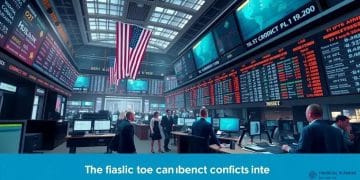Market reaction to Trump administration’s tariff policies

The market reaction to Trump administration’s tariff policies has led to significant volatility in stock prices, varied impacts across sectors, and shifts in investor sentiment, demonstrating the complexities of trade dynamics and economic adjustments.
Market reaction to Trump administration’s tariff policies is a topic that has stirred strong opinions and debates. How have these tariffs influenced global trade and investor confidence? Let’s dive into the details.
Understanding Trump’s tariff policies
Understanding Trump’s tariff policies is crucial to grasping the broader economic landscape of recent years. These policies significantly affected trade relations and market dynamics.
To get a clearer picture of these tariffs, let’s break down the key components.
What Are Tariffs?
Tariffs are taxes imposed on imported goods. They are intended to make foreign products more expensive, which in turn encourages consumers to buy American-made products. This can help protect domestic industries from international competition.
Major Tariff Categories
- Steel and Aluminum Tariffs: These tariffs aimed to support local steel and aluminum manufacturers.
- China Tariffs: Targeted over 300 billion dollars’ worth of Chinese imports to address trade imbalances.
- Specialized Product Tariffs: Included tariffs on items like electronics and agriculture.
The implementation of these tariffs triggered mixed reactions from different sectors. For instance, while some industries thrived under these protective measures, others faced rising costs.
Let’s not overlook the impact on unemployment. Rising tariffs sometimes lead to job losses in sectors reliant on imported goods. Businesses forced to raise prices may also reduce their workforce to maintain profit margins.
Additionally, Trump’s tariff policies have shaped international relations. Countries affected by these tariffs sought ways to retaliate, further complicating trade dynamics.
Economic Effects
Evaluating the economic effects of these tariffs reveals a complex picture. While they aimed to boost domestic production, many economists argued that they also inflated consumer prices.
There are several long-term implications for consumers and businesses:
- Increased prices for imported products.
- Shifts in supply chains as companies look for alternatives.
- Potential trade wars that could destabilize markets.
All these factors play into a larger narrative about the impact of Trump’s tariff policies on the economy and international trade.
In summary, understanding these policies helps to demystify their immediate and lasting effects on both the national and global economy.
Immediate market reactions and trends

The immediate market reactions to Trump’s tariff policies have been significant and varied. Investors quickly assessed the potential impacts on industries, leading to fluctuating stock prices.
Stock markets initially experienced volatility as news of new tariffs broke. Companies dependent on imports faced uncertainty, driving down their share prices. In contrast, U.S. producers of steel and aluminum saw an uptick in their stock valuations as these tariffs could boost their market share.
Sector-Specific Trends
Different sectors reacted uniquely to the tariff announcements. For instance, the technology sector felt immediate pressure due to increased costs of imported parts and materials.
- Manufacturing: American manufacturers benefited from reduced foreign competition, prompting a surge in domestic production.
- Retail: Retailers faced challenges as prices on imported goods rose, leading to potential decreases in consumer demand.
- Agriculture: Farmers encountered retaliation from countries like China, affecting exports.
Market analysts observed that consumer goods saw a ripple effect; higher tariffs led to rising prices at retail stores, prompting concerns about inflation. This dynamic created a more cautious consumer spending environment, influencing overall economic growth.
Moreover, as the tariff policies unfolded, investor sentiment shifted. Many began to adopt a wait-and-see approach, evaluating the long-term consequences before making significant investment decisions.
Economic Indicators
Several economic indicators reflected the immediate reactions to the tariffs. For example, the consumer confidence index showed fluctuations as people adjusted to the cost changes in goods they regularly purchase.
Manufacturing indices also reported mixed signals, with some companies expanding while others scaled back due to uncertainties surrounding the tariff impacts. This made it essential for investors to keep a close eye on these indicators to understand the broader implications.
Understanding the immediate market reactions and trends stemming from Trump’s tariff policies provides critical insights into the economic landscape and ongoing trade discussions.
Long-term effects on trade relationships
The long-term effects on trade relationships due to Trump’s tariff policies are significant and complex. Many countries felt the immediate impacts, but the extended consequences will shape global commerce for years to come.
As tariffs increased on specific goods, trading partners sought alternatives. This shift often led to strained diplomatic relations. For instance, countries affected by U.S. tariffs may retaliate with their own tariffs, creating a cycle of increasing tension.
Shifts in Global Supply Chains
One of the most profound impacts is the change in global supply chains. Companies based in the U.S. began to reassess their manufacturing locations. When faced with high tariffs, many businesses sought to relocate production overseas or diversify their supply sources.
- Diversification: Firms are now more inclined to source materials from multiple countries to avoid tariffs.
- Relocation: Some companies moved manufacturing to countries with lower tariffs or without tariffs at all.
- Partnerships: New trade agreements are emerging as countries look to create favorable terms outside of existing tariff constraints.
The result of these changes can lead to more competitive pricing in the long run as companies adapt to a new trade environment. However, this also risks alienating traditional trade partners, impacting long-standing economic relationships.
Trade partners that were once reliable suppliers may find themselves sidelined as new suppliers emerge. Over time, this could redefine alliances and market dependencies. For instance, Canada and Mexico may seek alternatives to U.S. goods, while countries in Southeast Asia might become more critical suppliers.
Economic Growth and Stability
The long-term effects of tariffs don’t just impact relationships; they also shape economic growth. Tariffs can slow economic growth as costs rise for consumers and businesses alike. The initial intention of protecting local industries can lead to a broader economic slowdown.
If American consumers pay more for imported goods, they might reduce overall spending. This potential decrease in demand can ripple through various sectors, leading to layoffs or reduced hours for workers. The net effect can be a more unstable economic environment.
In summary, the long-term effects of Trump’s tariff policies on trade relationships will continue to evolve. As the global landscape changes, businesses and nations must navigate the complexities of this new trade reality.
Sector-specific impacts and adaptations

Sector-specific impacts of Trump’s tariff policies have reshaped various industries, leading to distinct adaptations in response to the changing trade environment. Each sector faced unique challenges and opportunities after tariffs were implemented.
The manufacturing sector is one of the most affected areas. Higher costs for imported raw materials led many manufacturers to rethink their supply chains. As a result, some companies focused on increasing local production to mitigate the impact of tariffs.
Trade and Consumer Goods
Consumer goods sectors also experienced noticeable changes. With tariffs increasing prices on imported products, retailers had to navigate consumer sentiment carefully. This resulted in some businesses either passing on costs to consumers or seeking alternatives.
- Increased Prices: Many retailers raised prices on imported items, causing concern among shoppers.
- Product Sourcing: Some retailers switched to U.S. suppliers to avoid tariffs.
- Consumer Behavior: Shoppers began to shift preferences toward locally made goods to support American manufacturing.
The agricultural sector faced its own challenges as well. Farmers who relied on exports to countries affected by tariffs experienced disruptions. For instance, American soybean farmers struggled when China imposed tariffs on U.S. soybeans.
This situation led many farmers to diversify their markets. They sought new export opportunities in countries that were not subject to those tariffs, like some Southeast Asian nations.
Technological Innovations
In addition to shifting markets, technological innovations emerged in various sectors. Companies began to invest in automation and efficiency improvements to offset rising costs. This included adopting new production technologies that reduced labor and material costs.
As a reaction to market pressures, businesses also collaborated more with suppliers to enhance product offerings while controlling costs. This spirit of adaptation reflects how industries can transform in response to tariff challenges.
In summary, the sector-specific impacts of Trump’s tariff policies pushed industries to adapt quickly. The long-term effects of these adaptations will influence how sectors thrive in the future.
Investor sentiment and stock market responses
Investor sentiment and stock market responses to Trump’s tariff policies have been dynamic and unpredictable. As these policies were announced, the market reacted almost immediately, reflecting both optimism and concern among investors.
Initially, the stock market saw fluctuations. Some investors were hopeful that the tariffs would protect American jobs and industries, leading to short-term gains in certain sectors. However, uncertainty about the long-term impact created anxiety.
Market Volatility
Market volatility increased as analysts evaluated how tariffs would affect various industries. Here are some key responses:
- Sector Gains: Companies tied to steel and aluminum saw stock prices rise as tariffs promised protection from foreign competition.
- Consumer Goods Pressure: Retail stocks experienced declines due to fears of increased prices for imported goods.
- Technology Sector Concerns: Tech firms that relied on imported components faced potential production cost increases.
Investor sentiment was highly influenced by news cycles. Whenever new developments emerged regarding trade negotiations, market responses followed swiftly. Positive news could lead to a rally in stocks, while negative developments often resulted in sharp corrections.
Long-term Perspectives
In the long run, many investors began to reassess their strategies. Concerns about sustained economic growth due to tariffs led to more cautious investing. The unpredictability of trade relations pushed some investors to diversify their portfolios, seeking safer assets.
Moreover, as the trade tensions continued, conversations shifted toward the potential for a trade war. This influenced stock indices as investors weighed the risks of declining corporate profits. The sentiment around the stock market often mirrored broader economic indicators such as job reports and consumer confidence.
Overall, understanding investor sentiment and the evolving stock market responses to Trump’s tariff policies offers crucial insights into the interconnectedness of trade and economic health.
FAQ – Frequently Asked Questions about Market Reaction to Trump’s Tariff Policies
What are the immediate effects of Trump’s tariff policies on the stock market?
The immediate effects include heightened market volatility, as stocks of affected sectors fluctuate based on tariff announcements.
How have different sectors reacted to tariffs?
Sectors like manufacturing and agriculture have felt significant impacts, leading to adaptations in their supply chains and market strategies.
What has been the impact on consumer goods due to these tariffs?
Tariffs on imports have led to increased prices for consumer goods, prompting some retailers to seek domestic suppliers.
Why is understanding investor sentiment important?
Understanding investor sentiment provides insights into market trends and helps businesses make informed decisions in response to economic changes.





